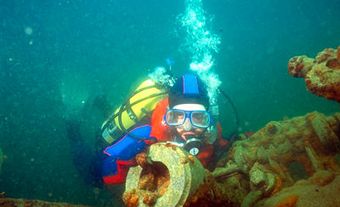
Saint-Jean, Lac
Lac Saint-Jean, 1003 km2, elevation 98 m, 63 m deep, is located in south-central Québec, 206 km north of the St Lawrence River, into which it flows via Rivière SAGUENAY. The lake is the centre of a shallow glacial pan and is fed by dozens of little rivers, the most important being (west to east) the Ashuapmushuan, the Mistassini and the Péribonka to the north and the des Aulnaies, Métabetchouane and the Ouiatchouane to the south. It is lined by various towns, among them ALMA, DOLBEAU-MISTASSINI, ROBERVAL and SAINT-FÉLICIEN. Called Piékouagami ("flat lake") by the INNU because of its shallow waters, the lake was named after the patron saint of Jean Dequen, a Jesuit missionary and the first European to reach its shores (1647).The Kakouchaks, the local population of Innu, began trading with the Europeans at TADOUSSAC in the 16th century. Later, Lac Saint-Jean was made part of the King's Domain (1674), land reserved for trapping and farmed out to interested parties; a first trading post was built at Métabetchouane in 1676.
The FUR TRADE dominated the region's economy until the 19th century, when colonization started in the Saguenay (1838) and then in the Lac Saint-Jean region (1849). Settlement was intense until the early 20th century, with settlers recruited from Québec, the US and even Europe. The economy was mainly based on agriculture and forestry until World War II. Co-operative dairy farming and cattle raising are still very important activities.
Industrial development began with 19th-century sawmills, continued with pulp mills (the first, at VAL-JALBERT, in 1901), paper mills (after 1925) and aluminum plants (1943), and was greatly encouraged by the construction of hydro stations at Alma (1923) and on the Rivière Péribonka (1951-60). Lac Saint-Jean also has a flourishing summer resort industry. Ever since the railway reached Roberval (1888), sportfishing (landlocked salmon and PICKEREL) has drawn thousands of enthusiasts yearly, along with vacationers who enjoy the lake's beaches.
A major swimming event, Traversée Internationale du Lac-Saint-Jean, between Péribonka and Roberval, has been held yearly since 1955. Péribonka also houses the Musée Louis-Hémon, commemorating the trip made to Lac Saint-Jean by the author of MARIA CHAPDELAINE. Parc de la Pointe-Taillon lies on the north shore of the lake.

 Share on Facebook
Share on Facebook Share on X
Share on X Share by Email
Share by Email Share on Google Classroom
Share on Google Classroom

